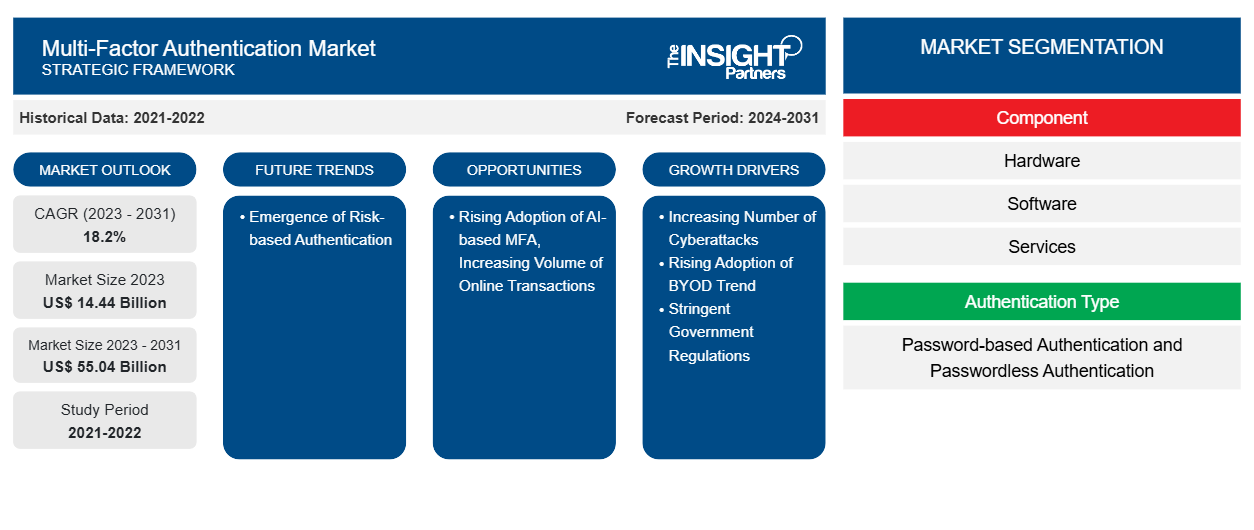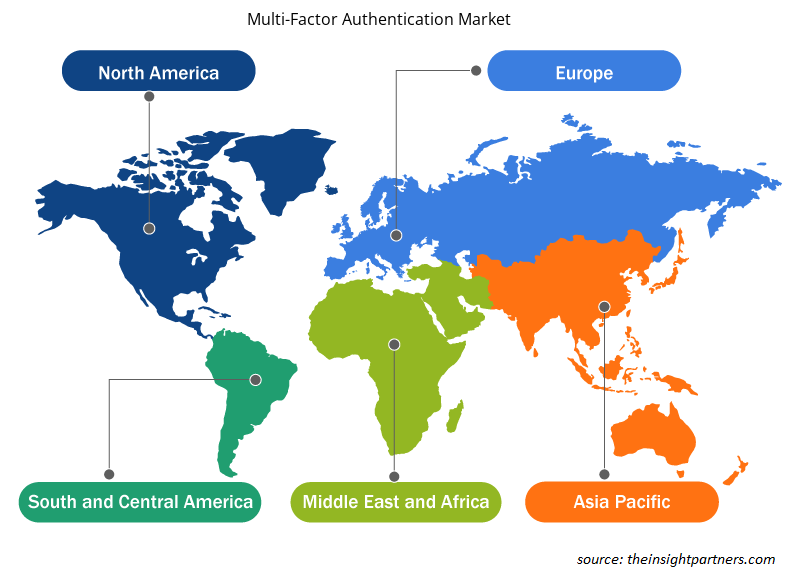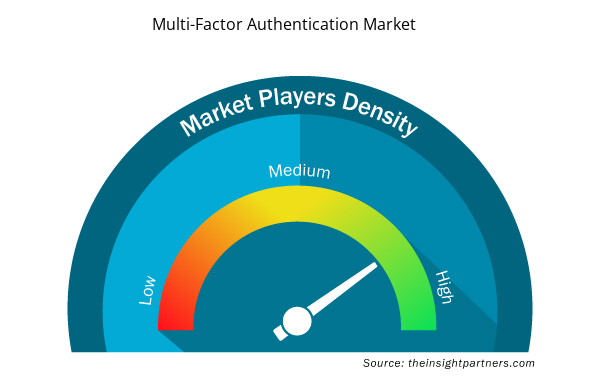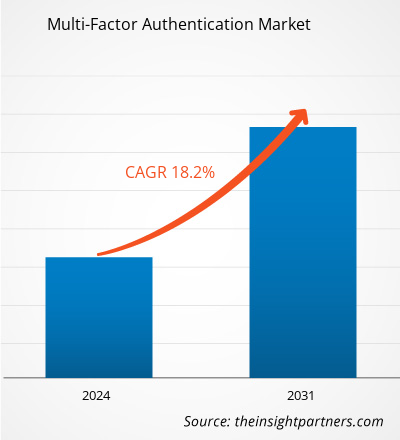The multi-factor authentication market size is projected to reach US$ 55.04 billion by 2031 from US$ 14.44 billion in 2023; it is estimated to record a CAGR of 18.2% from 2023 to 2031.
Risk-based authentication is likely to remain key multi-factor authentication market trends.
Multi-Factor Authentication Market Analysis
Digital security is important in today's business environment as businesses and users store crucial and sensitive information online. There is an increase in interaction with services, applications, and data that are stored over the Internet. A data breach or misuse of this online stored information could lead to serious financial theft, business disruption, and loss of privacy. In such a scenario, multi-factor authentication solutions can provide protection, creating an additional layer of security to block unauthorized users from accessing online accounts. Businesses use multi-factor authentication solutions to validate user identities and also to provide quick and convenient access to authorized users. The impact caused by the COVID-19 crisis forced many companies to adopt remote work solutions, making multi-factor authentication a requirement to protect the company’s data. A majority of companies have started to deploy multi-factor authentication solutions. Further, the adoption of MFA was largely driven by government regulations for enhanced cybersecurity to protect consumer data. Moreover, increasingly costly attacks and rising BYOD trends are significantly driving organizations to adopt and deploy multi-factor authentication solutions.
Multi-Factor Authentication Market Overview
Multi-factor authentication (MFA) refers to an authentication method that involves a multi-step account login process rather than just a password. A multi-factor authentication (MFA) solution needs the user to provide two or more verification parameters to gain access to their resources such as an application, online account, or a VPN. MFA is a key component of identity and access management, and it creates extra security to prevent unauthorized users from accessing critical accounts. The goal of multi-factor authentication is to create a layered defense that makes it more difficult for cyberattacks to access resources such as physical location, network, computing device, or database. MFA provides numerous benefits such as improved trust, reduced costs, enhanced organization security, and compatibility with Single Sign-On (SSO), along with meeting regulatory compliances and enabling enterprise mobility.
Customize This Report To Suit Your Requirement
You will get customization on any report - free of charge - including parts of this report, or country-level analysis, Excel Data pack, as well as avail great offers and discounts for start-ups & universities
Multi-Factor Authentication Market: Strategic Insights

- Get Top Key Market Trends of this report.This FREE sample will include data analysis, ranging from market trends to estimates and forecasts.
Customize This Report To Suit Your Requirement
You will get customization on any report - free of charge - including parts of this report, or country-level analysis, Excel Data pack, as well as avail great offers and discounts for start-ups & universities
Multi-Factor Authentication Market: Strategic Insights

- Get Top Key Market Trends of this report.This FREE sample will include data analysis, ranging from market trends to estimates and forecasts.
Multi-Factor Authentication Market Drivers and Opportunities
Increasing Number of Cyberattacks Across Enterprises
Businesses are facing continuous threat of cybercrimes, as they have grown more widespread in recent years. According to Embroker Insurance Services LLC, cyberattacks were considered the fifth top-rated risk in 2020, and cases continue to rise with technological advancements. Computer malware, data breaches, and denial of service (DoS) are a few examples of cyber risks. During the COVID-19 pandemic, cybercriminals took advantage of misaligned networks as businesses were shifting to remote working environments. According to OneLogin, cybercrime costs more than US$ 1 trillion worldwide, as 37% of organizations were affected by ransomware and 61% were affected by malware attacks in 2020. Between 2019 and 2020, cyberattacks in the US have increased by 139% as the country registered a staggering 145.2 million cases in Q3 2020. Malware attacks increased by 358% in 2020 when compared to 2019. Similarly, according to the Clusit Report, cyberattacks across the globe have increased by 10% in 2021 when compared to the previous year. For instance, according to AAG, the UK had the highest figure of cybercrime victims per million internet users (4,783 users) in 2022, an increase of 40% over 2020 figures. The average cost of a cyber breach was US$ 4.35 million in 2022, and it is predicted that this value is expected to reach US$ 10.5 trillion by 2025. Multi-factor authentication is emerged as the most important solution that companies can adopt in order to defend against online attacks. According to Microsoft, using a multi-factor authentication solution can block 99.9% of all attacks. Thus, the increasing number of cyberattacks in enterprises drives the multi-factor authentication market.
Rising Adoption of AI-based MFA
Multi-factor authentication (MFA) is a security solution that requires users to provide multiple forms of identification while logging into a system. Multi-factor authentication is an essential tool for preventing unauthorized access and has become increasingly common in recent years. The usage of AI in multi-factor authentication is a relatively new development. It is anticipated to become a popular choice for authentication due to its ability to verify the identity of a user by analyzing their behavior.
Usage of AI in multi factor authentication (MFA) has emerged as a powerful tool to bolster security measures and protect sensitive information. By leveraging AI technology, organizations can enhance the effectiveness and resilience of their multi-factor authentication solutions, thereby mitigating potential risks and fortifying their digital identities. Technologies such as AI can be used in many ways to improve the security of multi-factor authentication systems. As AI-based MFA systems are able to learn and adapt over time, they become increasingly proficient at identifying and foiling fraudulent activities. Furthermore, real-time identity verification via AI makes it difficult for hackers to pretend to be a user. One of the most promising applications of AI for multi-factor authentication is behavioral biometrics. Through behavioral biometrics, AI verifies the identity of a user by analyzing their behavior and comparing it to a database of known patterns. Using behavioral biometrics, the system monitors a user's typing style, phone grip, and even distinctive gait. Businesses nowadays are looking to improve their security and are increasingly implementing an AI-based multi-factor authentication system. They can also be used to verify the identity of users in real-time. Thus, rising adoption of AI-based MFA is anticipated to create lucrative opportunities for the multi-factor authentication market growth during the forecast period.
Multi-Factor Authentication Market Report Segmentation Analysis
Key segments that contributed to the derivation of the multi-factor authentication market analysis are deployment, size, and application.
- Based on component, the market is segmented into hardware, software, and services. In 2023, the software segment held a larger share of the market.
- Based on authentication type, the market is bifurcated into password-based authentication and passwordless authentication. The password-based authentication segment dominated the market in 2023.
- Based on model type, the multi-factor authentication market is segmented into two-factor authentication, three-factor authentication, four-factor authentication, and five-factor authentication. The two-factor authentication segment dominated the market in 2023.
- Based on end user, the market is segmented into IT & telecom, BFSI, education, government, healthcare, and others. The IT & telecom segment dominated the market in 2023.
Multi-Factor Authentication Market Share Analysis by Geography
- The multi-factor authentication market is segmented into five major regions—North America, Europe, Asia Pacific (APAC), the Middle East & Africa (MEA), and South & Central America. North America dominated the market in 2023, followed by Europe, South & Central America, and APAC, respectively.
- North America is one of the fastest-growing regions in terms of both technological innovations and the adoption of advanced technologies. The region also has a well-established IT & cloud infrastructure. In the past three years, North America has witnessed huge adoption of emerging technologies such as artificial intelligence, machine learning, and blockchain across all the major industry verticals. With the increasing penetration of digitization in various industries, verification and authentication have become vital components of business transaction ecosystems, especially in financial institutions and online retail. The demand for multi-factor authentication solutions in companies is increasing rapidly as these solutions allow companies to comply with various rules and regulations. A few of these regulations include anti-money laundering (AML), know your customer (KYC), and digital fraud prevention. The North America multi-factor authentication market growth is primarily driven by rising demand from industrial sectors such as BFSI, government, defense, and healthcare, where protection against cyberattacks is a crucial business requirement for successful operations.
Multi-Factor Authentication Market Regional Insights
The regional trends and factors influencing the Multi-Factor Authentication Market throughout the forecast period have been thoroughly explained by the analysts at Insight Partners. This section also discusses Multi-Factor Authentication Market segments and geography across North America, Europe, Asia Pacific, Middle East and Africa, and South and Central America.

- Get the Regional Specific Data for Multi-Factor Authentication Market
Multi-Factor Authentication Market Report Scope
| Report Attribute | Details |
|---|---|
| Market size in 2023 | US$ 14.44 Billion |
| Market Size by 2031 | US$ 55.04 Billion |
| Global CAGR (2023 - 2031) | 18.2% |
| Historical Data | 2021-2022 |
| Forecast period | 2024-2031 |
| Segments Covered |
By Component
|
| Regions and Countries Covered | North America
|
| Market leaders and key company profiles |
Multi-Factor Authentication Market Players Density: Understanding Its Impact on Business Dynamics
The Multi-Factor Authentication Market market is growing rapidly, driven by increasing end-user demand due to factors such as evolving consumer preferences, technological advancements, and greater awareness of the product's benefits. As demand rises, businesses are expanding their offerings, innovating to meet consumer needs, and capitalizing on emerging trends, which further fuels market growth.
Market players density refers to the distribution of firms or companies operating within a particular market or industry. It indicates how many competitors (market players) are present in a given market space relative to its size or total market value.
Major Companies operating in the Multi-Factor Authentication Market are:
- Microsoft
- Thales.
- Okta
- OneSpan
- HID Global Corporation
- Cisco Systems, Inc.
Disclaimer: The companies listed above are not ranked in any particular order.

- Get the Multi-Factor Authentication Market top key players overview
Multi-Factor Authentication Market News and Recent Developments
The multi-factor authentication market is evaluated by gathering qualitative and quantitative data post primary and secondary research, which includes important corporate publications, association data, and databases. The following is a list of developments in the multi-factor authentication market:
- n October 2023, Amazon Web Services (AWS) announced a plan to mandate multi-factor authentication from 2024 to improve default security and reduce the risk of account hijacking
(Source: Amazon Web Services, Press Release)
- In April 2022, Trust Stamp announced the launch of a multi-factor authentication solution named “Biometric MFA” to replace traditional password-based MFA with selfie biometrics. Biometric MFA lets partners layer intuitive, convenient, and seamless identity authentication where vulnerable passcodes are used
(Source: Trust Stamp, Press Release)
Multi-Factor Authentication Market Report Coverage and Deliverables
The "Multi-Factor Authentication Market Size and Forecast (2022–2030)" provides a detailed analysis of the market covering the areas mentioned below:
- Market size and forecast at global, regional, and country levels for all the key market segments covered under the scope
- Market dynamics such as drivers, restraints, and key opportunities
- Key future trends
- Detailed PEST/Porter's Five Forces and SWOT analysis
- Global and regional market analysis covering key market trends, major players, regulations, and recent market developments
- Industry landscape and competition analysis covering market concentration, heat map analysis, prominent players, and recent developments
- Detailed company profiles
- Historical Analysis (2 Years), Base Year, Forecast (7 Years) with CAGR
- PEST and SWOT Analysis
- Market Size Value / Volume - Global, Regional, Country
- Industry and Competitive Landscape
- Excel Dataset



Report Coverage
Revenue forecast, Company Analysis, Industry landscape, Growth factors, and Trends

Segment Covered
Component, Authentication Type, Model Type, and End User

Regional Scope
North America, Europe, Asia Pacific, Middle East & Africa, South & Central America

Country Scope
This text is related
to country scope.
Frequently Asked Questions
The global multi-factor authentication market is expected to reach US$ 55.04 billion by 2031.
The global multi-factor authentication market was estimated to be US$ 14.44 billion in 2023 and is expected to grow at a CAGR of 18.2% during the forecast period 2024 - 2031.
The incremental growth expected to be recorded for the global multi-factor authentication market during the forecast period is US$ 40.59 billion.
Emergence of risk-based authentication is anticipated to play a significant role in the global multi-factor authentication market in the coming years.
Increasing number of cyberattacks, rising adoption of BYOD trend and stringent government regulations are the major factors that propel the multi-factor authentication market.
The key players holding majority shares in the global multi-factor authentication market are Microsoft, Okta, Cisco Systems, Inc, Thales, RSA Security
Trends and growth analysis reports related to Technology, Media and Telecommunications : READ MORE..
The List of Companies - Multi-factor Authentication Market
- OneSpan
- Entrust Corporation
- CyberArk Software Ltd.
- RSA Security
- HID Global Corporation
- Cisco Systems, Inc.
- Ping Identity.
- Microsoft
- Thales.
- Okta

 Get Free Sample For
Get Free Sample For